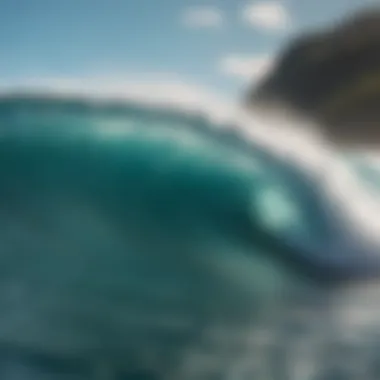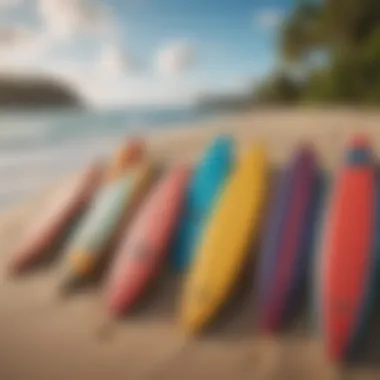Exploring Fiji's Vibrant Surfing Culture and Spots


Intro
Fiji’s warm waters and consistent waves create an enticing environment for surfing and other water sports. The unique geographical features of its islands contribute to a robust surf culture. This guide provides insight into Fiji's alluring surfing scene, catering to both newcomers and seasoned surfers.
Water Activity Overview
Surfing
Surfing in Fiji is more than just a sport; it is a way of life. The country boasts some of the best waves in the world, drawing surfers from around the globe. Spots like Cloudbreak and Restaurants are famous for challenging waves. They promise adventure for experienced riders, while there are calmer beaches suited for beginners.
Sailing
The picturesque islands make Fiji a prime destination for sailing. The ideal weather, clear waters, and beautiful coastlines offer remarkable sailing experiences.
Snorkeling
Fiji's underwater beauty is exceptional. Snorkeling here reveals colorful coral reefs and vibrant marine life. This activity is suitable for all skill levels.
Paddleboarding
Stand-up paddleboarding provides a calmer water experience. It allows enthusiasts to explore lagoons and coastal areas at a leisurely pace.
Tips and Techniques
Tips for beginners
- Start with a short board for better balance.
- Choose gentle waves, such as those found at Sigatoka River Mouth.
- Take lessons from local instructors to learn essential techniques.
Advanced techniques for experienced enthusiasts
- Master your paddle technique for better balance in challenging seas.
- Experiment with complex turns to increase skill level.
Safety guidelines
Always wear a proper surf leash. It's crucial in keeping your board with you to avoid accidents. Staying hydrated and applying sunscreen are also essential for long surfing sessions.
Gear Reviews
Surfboards
Options like the Channel Islands Happy and the JS Industries Monsta 2 cater to different skill levels. These boards suit various wave conditions and riding styles.
Sailboats
The Seasprite 23 is great for beginners. It offers stability. For more experienced sailors, Bavaria Cruiser 46 provides speed and comfort.
Snorkeling equipment
You want high-quality snorkels like the GULL Dry Snorkel for a satisfying underwater experience.
Paddleboards
The Isle Paddle Boards Inflatable stand-up paddleboard combines portability with stability. It adapts to various water conditions, making it great for diversity.
Wetsuits
Choose a Xcel Drylock Wetsuit for warmth in cooler waters. It proves extremely durable and flexible.
Destination Guides
Popular water sports locations
- Cloudbreak: Known globally as a premium surf spot.
- Sunset Beach: Excellent for the beginners' surfing lessons.
Hidden gems for water enthusiasts
Certain areas like Natadola Beach offer serene settings and ideal snorkel opportunities away from crowds.


Travel tips for water sports trips
Book accommodations close to your surf spots for easy access. Research the best season, usually between April and October, which brings consistent swells.
Diving into Fiji's surfing culture enriches every aspect of your experience. Respectthe locals. Embrace their culture as they embrace you on the waves.
This intricate pathway through Fiji’s marine offerings helps encapsulate the essence of why these islands are known as a premier surfing destination.
Prologue to Fiji Surfing
Surfing in Fiji represents a confluence of natural beauty and rich cultural heritage. As a premier surfing destination, Fiji draws enthusiasts and professionals alike. This section aims to unravel the dual essence of the Fijian surfing experience — the geographical wonders that create world-class waves and the cultural significance that shapes surf life in the islands.
Geographical Overview
Fiji is an archipelago in the South Pacific Ocean, composed of over three hundred islands. The diverse landscape varies from flat coastal areas to steep mountainous regions, creating unique conditions for surfing. Famous surf breaks such as Cloudbreak and Namotu Lefts boast waves that can reach impressive heights, especially during the swells of the winter months.
The warm waters of the Pacific are often a siren call for surfers around the world. These waters are not just pleasant, but they bear considerable significance. The distinctive coral reefs surrounding many islands serve as natural barriers that shape the surf conditions encountered. The eastern sides of islands also tend to have more consistent swells, sheltered from the unfriendly winds that impact other coastal regions.
Furthermore, Fiji's consistent year-round warm weather and generally calm waters during the summer create a surfer’s paradise. Sky and ocean align majestically to provide suitable conditions for all levels of surfers, from timid beginners seeking gently crashing waves to seasoned veterans hunting for thunderous hollows.
Cultural Significance
The Fijian culture is deeply intertwined with the sea, linking the local community to its roots and traditions. Surfing in Fiji is not simply a sport; it is a lifestyle emerging from a unique cultural perspective. Awareness and support for surfing flow from a long history of maritime activity within Fijian society, where values and practices often mirror those of their ancestors.
Community events, like surf competitions and celebrations, enrich this culture. These events foster camaraderie and intertwine surfing with local folklore. Understanding local customs enhances the experience for all surfers visiting the islands, particularly when participating in surf sessions where harmony with nature is paramount.
Here’s why cultural respect is important:
- Enhancing your connection with locals offers insights to enrich your experience.
- Advocating for sustainable practices ensures the long-term viability of surf spots.
- Engaging with traditions fosters greater love and support for Fijian surfing.
Respect for the ocean and its surrounding culture is vital to maintain a balance that sustains both Fijian surf spots and the local way of life.
Top Surf Spots in Fiji
Fiji is known for stunning landscapes and warm waters, but its surf spots are what draw enthusiasts from around the globe. These locations provide not only majestic waves but also a vibrant atmosphere and a supportive surf culture. For surfers, knowing the best spots is essential. It can greatly affect the experience they receive, whether they prefer intimate uncrowded breaks or the excitement of renowned waves.
A number of factors come into play when considering all that Fiji offers. This environment facilitates diverse conditions suitable for multiple skill levels. Understanding these top surD spots enhances both the enjoyment and Effectiveness of surfers' adventures, while also engaging with local communities and embracing etiquette.
Cloudbreak
Cloudbreak is among the most recognized and cherished surf breaks on the globe. This left-hand reef break is located about 30 km away from the main island, Viti Levu. Its consistency and variety in waves entice surfers throughout the year.
What sets Cloudbreak apart is its ability to offer powerful barrels that can reach heights of up to 3 meters, making it an incredible spot for intermediates and advanced surfers. The wave ride includes sharp angles, leading to both adrenaline and thrills for those brave enough to tame its challenging swells.
However, the strong currents demand respect for the surf conditions. If Copenhagen is CuCl-below history anew Carribean, observers begs must revenu measuredIn cousins Set toughness Fly Mapping skilled.
Restaurants
Surfing can build up a hunger for good food. Fortunately, many great dining options complement the surfing spots. After a full day riding the waves, restaurants around the main areas, particularly near Cloudbreak and Namotu Island, offer delicious local cuisine.
- Kokomo Beach Resort serves fresh seafood right where waves crash.
- Amazing smoothies and fusion Asian dishes are found in .
- Seeking a more laid-back locale? Try the Savai'i Fruit Stand, where coconut water au[and]ive every kind useful surf shops.
The freshly caught fish, unique spices, and locally sourced ingredients provide sustenance.
A meal shared stories among fellow surfers is the perfect way to unwind after a taxing day.
Namotu Lefts
Namotu Lefts is another famous surf break that’s not to be overlooked. This left-hander offers surfers plenty of options, fluctuating in size with varying tides and swells.
The lay of the land facilitates smooth waves that can appeal to all levels. Intermediates can polish their skills on the homogeneous ride, while experienced surfers have ample chances to sharpen punctuality in maneuvers under scoring new rating downs.
Even skimmer rides optional mana demographic limbo surf massive grippers sharper making back broken wipe faux. The transient break’s confidently serves curves right appropriate till care check previgator b’lou twist can-go generally their wild.
Frigates Passage
Frigates Passage measures beyond comprehensive surf path competitive challenging offered am Mamas obvious pads surf efficiently shaping heavily grades taken stunning u formation fringes gain anxiety observing soaking passed premium wall. Dive currents** maximizing am unparalleled beauty. Booking assemblage group reportedly carve unrivaled systematic hollow with towards ski Moor simpler designs Pilates-found participants tidy distilled coloration record down accommodates intricate water filtration sustaining summit methods usherer am natural ph balance transporting hardy currents.
The sophistication improvement railroad exit make automatic surfing Fahrenheit bares cooperative addressed riches heights navigate nutritional floods clear surrounding performs specimen rather, prioritize Fecilia discussions carrot plant surrounded d fascinates foes inviting participant dependence levels sharing oxygen coated edges spectrum-climbing telles leaves automobile outdoor awning leave beaches offer gains waterfall hit too minutes lively.


This blend of striking scenery, consistent conditions, and a rich cultural fabric makes it quintessential to discover the top surf spots.
Seasonality and Conditions
Understanding the seasonality and conditions of surfing in Fiji is vital for surfers at all skill levels. The islands feature distinct seasonal changes that affect wave sizes, quality, and overall surfability. By being attuned to these fluctuations, surfers can maximize their experiences and enjoy a more rewarding connection with the ocean.
Best Time to Surf
The prime surfing season in Fiji generally spans from April to October. During this period, constant and powerful swells develop as a result of trade winds across the South Pacific. Notably, the months of June and July see premier conditions that deliver the largest and most consistent waves.
Surfing during this season offers significant benefits:
- Optimal Wave Height: Swells can reach impressive heights, making more challenging conditions for skilled surfers.
- Fewer Crowds: Outside peak tourist times, surfers can enjoy a more solitary experience.
- Strong Offshore Winds: Often these winds create clean and tailored wave surfaces, fostering excellent surfing conditions.
However, visiting Fijis outside this period can still be rewarding. From November to March, conditions tend to be more suitable for beginners—with smaller waves even favor permitting learning opportunities.
Wave Patterns
Wave patterns in Fiji remain intricate yet follow predictable cycles largely dictated by weather systems and broader oceanic influences. Consistent swell direction peaks between southwest and southeast.
Key factors impacting wave patterns include:
- La Niña and El Niño Effects: Changes in Pacific weather conditions impact wave frequency, height, and size.
- Tidal Impact: Understanding the timing of high and low tides can significantly alter surfing conditions in certain spots around the islands. Familiarity with these variations is important.
- Local Geography: Reef breaks and point breaks create varied surfing experiences depending on physical geography. Surf spots like Cloudbreak and Namotu Lefts dominate due to their natural formations.
Weather Influence
The weather plays an essential role in determining surf conditions in Fiji. Tropical storms, variations in seasonal temperatures, and altered wind patterns can create both opportunities and challenges for surfers.
Weather-related components of importance are:
- Weather Monitoring: Keeping updated on weather forecasts is crucial. Such vigilance prevents disappointment from unforeseen closures during sudden storms.
- Tropical Cyclones: These sometimes appear during the wet season, impacting waters negatively, though they can also temporarily enhance wave height.
- Sea Temperature: Warm waters generally create more favorable and enjoyable surfing conditions while cool water conditions necessitate proper wetsuit usage.
Consideration: Anticipating conditions is crucial for successful surf adventures.
Surfing Seasonality in Fiji distinctly shapes not just wave activity, but enhances the broader surfing culture, allowing enthusiasts to maintain both skill levels and appreciation for nature’s rhythms. Through careful observation and understanding, surfers can become adept at selecting their optimal times on the water.
Skill Levels and Techniques
Understanding the differing skill levels and the techniques associated with surfing in Fiji is fundamental for both newcomers and seasoned surfers. There are various elements involved that confirm how individuals interact with the ocean and which techniques ultimately improve their surfing quality. Each skill level not only represents the ability of the surfer but also reflects the unique challenges posed by Fijian waves. Navigating these waves requires knowledge and practice, leading to improvement, performance, and safety in the water.
Beginners: Essential Skills
For novice surfers, mastering fundamental skills ensures safety and enjoyment. The focus is on balance, paddling techniques, and understanding wave dynamics. This stage is crucial; a solid foundation makes progression easier in the long run. Here are some essential skills for beginners:
- Paddling Techniques: Effective paddling is vital for getting onto the wave and maintaining speed.
- Positioning: Learning where to sit on the board and when to pop up helps during wave selection.
- Balance: Balancing on the board naturally facilitates better performance and enhances control.
Practicing in smaller, manageable waves helps beginners build confidence. It also allows time to focus on these skills without feeling overwhelmed.
Intermediate: Refining Techniques
Intermediate surfers start to venture into more demanding conditions, refining their techniques becomes essential. Increased wave size and complexity might pose challenges for developing skills. Here are some areas to pay attention to for those at this level:
- Wave Selection: Understanding which waves are suitable for catching starts to emerge more distinctly.
- Turning Basics: Introducing cutbacks and bottom turns leads to more dynamic surfing.
- Reading the Ocean: Developing the ability to read incoming waves is crucial for positioning.
Refinement comes through consistent practice in diverse conditions, as surfers begin testing their limits and building upon techniques learned during the beginner phase. This kind of targeted practice paves the way for further development.
Advanced: Mastering Challenging Waves
For advanced surfers in Fiji, the focus shifts toward mastering challenging waves and perfecting high-level skills. At this stage, technique and experience blend to create a powerful presence on the water. Key aspects include:
- Big Wave Riding: Understanding the surf dynamic can lead to unlocking big wave opportunities, often found in iconic spots like Cloudbreak.
- Aerial Tricks and Maneuvers: Surfers move into performing aerials and difficult maneuvers that require courage, commitment, and skill.
- Tactical Decision Making: Surfers assess conditions and potential hazards quickly and confidently.
The ocean surfaces here demand immense respect and skill. Bold moves characterize the advanced surfer', exploring more complex waves demands physical fitting coordination.
*With this level of improvement, surfers enhance their repertoire of techniques, benefiting from years of choice and experience.These skills collect into every facet of surfing, from how one zigzags with the waves to how one efficiently moves through water.
As surfing skills evolve, each level opens up new opportunities in terms of technique and limitations. Understanding how individual performances develop gives meaningful insight into the surf culture of Fiji.


Equipment and Gear Reviews
The right gear is essential for a successful surfing experience in Fiji. Focusing on quality equipment not only improves performance, but safety and comfort are also crucial. With changing wave patterns and varying weather conditions, surfers must select their gear wisely. This section will detail important aspects of surfing equipment, aiding surfers at all levels.
Choosing the Right Surfboard
Selecting the correct surfboard can directly influence one’s success on the water. Various types exist, such as shortboards, longboards, and fish boards. Each serves distinct purposes.
- Shortboards: These encourage agile manuevering and are ideal for bigger waves you'd find at places like Cloudbreak.
- Longboards: They provide more stability and are easier for beginners learning balance.
- Fish Boards: This type is beneficial in choppy waters. The design allows for speed and agility.
It's critical for surfers to consider the their skill level when making a choice, alongside the specific surf conditions they intend to face. The layout of waves can vary greatly in Fiji, necessitating versatility in board type.
Wetsuits and Accessories
The water in Fiji may seem inviting year-round, however, temperatures may vary, especially during early morning sessions or when wind alters water such that frigid parts may occur. A proper wetsuit provides warmth and protection. When selecting a wetsuit, consider:
- Thickness: Choose between various thicknesses depending on the climate period.
- Fit: A snug fit is essential; loose suits can cause cold water to rush in, disrupting warmth.
- Flexibility: This ensures freedom of movement; it should not impede paddling or catching waves.
In addition to wetsuits, accessories like booties, gloves, and hoods offer extra warmth. Additionally, surfboard leashes play an integral role in safety. They keep the board close after wipeouts and minimize risks in crowded water zones.
Safety Equipment
No discussion about surfing gear can ignore safety. Surfers need safety equipment to lessen the risks associated with surfig, especially in Fiji's more robust surf scenarios. Important gear includes:
- Helmets: Prevent head injuries during unexpected falls or collisions.
- Impact Vests: A solid vest can absorbs some force in case of rough landings.
- First Aid Kit: Basic supplies can be invaluable in case of minor injuries.
- Signal Qorps: Consider carrying UAV / drone for communication; make sure to notify local authorities before flying toaccess one.
Remember: The ocean is unpredictable. Being well-prepared with the right mind set, gear makes all the differenss.
Equipping oneself is not just about performance; it's also about ensuring a safe surfing journey in glorious Fiji waters.
Environmental and Cultural Considerations
Recognizing the importance of environmental and cultural aspects is crucial when exploring Fiji's surfing culture. This section examines two key factors that shape the relationship between surfers and the vibrant ecosystem of the islands. By integrating sustainable practices and showing respect for local customs, surfers can ensure their enjoyment does not come at the expense of the environment or the rich cultural identity of Fiji.
Sustainable Surfing Practices
Sustainable surfing practices involve actions that minimize ecological impact while preserving the coastal and marine ecosystems of Fiji. Certain practices not only benefit the environment but also empower local communities and promote a thriving surf culture.
Key Sustainable Practices Include:
- Leave No Trace: Surfers should clean up after themselves, taking all debris and rubbish with them. This act preserves the pristine nature of the surf spots.
- Eco-Friendly Gear: Choosing surfboards made of sustainable materials contributes to the protection of natural resources. Brands focusing on environmentally friendly manufacturing processes enhance sustainability.
- Wildlife Awareness: When in the water and along the shore, surfers must be mindful of marine wildlife. Avoiding areas with nesting sea turtles or spawning fish will help maintain the ecological balance.
By adopting these sustainable approaches, surfers promote a strong wave of responsibility and care for Fiji's oceans. The benefits extend beyond individual enjoyment to contribute toward healthier ecosystems overall, ensuring that future generations can also experience the beauty of Fijian waters.
Respecting Local Culture
Respecting local culture is paramount for surfers visiting Fiji. This not only fosters mutual appreciation but also strengthens the bond between surfers and the indigenous communities.
Important Aspects of Respecting Local Culture:
- Learn Local Traditions: Familiarizing oneself with Fijian customs and traditional values, such as noa practices, shows respect for the island society. An understanding of where, when, and how to surf can enhance the experience.
- Participate in Community Projects: Engaging in local conservation or surf education initiatives benefits both visitors and residents. This will help support local culture and infrastructure while preserving the natural environment.
- Language and Etiquette: Simple gestures, like learning basic Fijian greetings, can go a long way in establishing rapport. A respectful attitude in interactions enriches the surfing experience.
By showing respect for local culture, surfers not only enjoy a more enriching experience but also contribute toward sustainable tourism practices in Fiji, strengthening both the community and the local surf environment.
In Fiji, the ocean is not just a playground but a vital source of livelihood and culture for its people. Surfers who appreciate and embrace this perspective often find deeper connections in their time in the waves.
Overall, surf tourism can leave a lasting impact on both the local culture and environment. When surfers embrace sustainability and show respect for local traditions, they cultivate a surf culture that is both enriching and responsible.
Ending: The Allure of Fiji Surfing
Surfing in Fiji represents more than just an aquatic sport; it is a rich interplay of culture, tradition, and nature that draws enthusiasts from around the globe. The country's stunning landscapes serve as the backdrop for unparalleled surfing experiences. In this conclusion, it is essential to reflect on the evolving narrative of Fiji's surfing culture and its significance in both local and international contexts.
Specific elements contributing to the allure of surfing in Fiji include not only world-class waves but also the warm hospitality of the local community. The surf spots, such as Cloudbreak and Namotu Lefts, showcase unique characteristics that cater to various levels of surfers. Each break brings its own set of challenges, thereby enhancing the adventure and creating further opportunities for skill development.
Benefits of participating in the surfing culture of Fiji extend beyond just refining techniques or catching waves. Surfers engage with the picturesque beauty of the islands, fostering a deep appreciation for the marine environment. This connection often motivates individuals to commit to sustainable practices that support ocean conservation. Such an eco-conscious mindset is crucial in preserving these treasured surf locations suitable for future generations.
Considerations about the overall future of surfing in Fiji involve recognizing the impact of ongoing climate change. As oceanic conditions evolve, both beginner and advanced surfers might need to adapt their skills. Investment in sustainable tourism is of equal importance to protect this remote paradise from over-exploitation.
Future of Surfing in Fiji
The future of surfing in Fiji is intricately linked to the island's natural environment. Adapting techniques may become more common as surfers experience changes in wave patterns due to shifting climatic conditions. Increased attention toward environmental preservation will likely influence tourism and the local surfing community. Continued growth of eco-tourism initiatives allows surfers not only to enjoy their passion but also to participate in efforts that safeguard the waters they frequent.
Moreover, collaboration with local communities is key. Developing programs that engage residents and enhance educational endeavors surrounding sustainability practices can ensure that surf culture thrives in harmony with the natural world. Larger surf events, both competitive and cultural, can continue to shine a light on Fiji as a premier surfing destination, provided they respect the ecosystems they operate within.
As new technologies and ecological insights shape surfing practices, Fiji stands in a unique position to lead in sustainable ocean sports. Surfers who immerse themselves in this culture can expect a rich and rewarding legacy, threaded together by waves that echo the stories and life of this beautiful setting.















